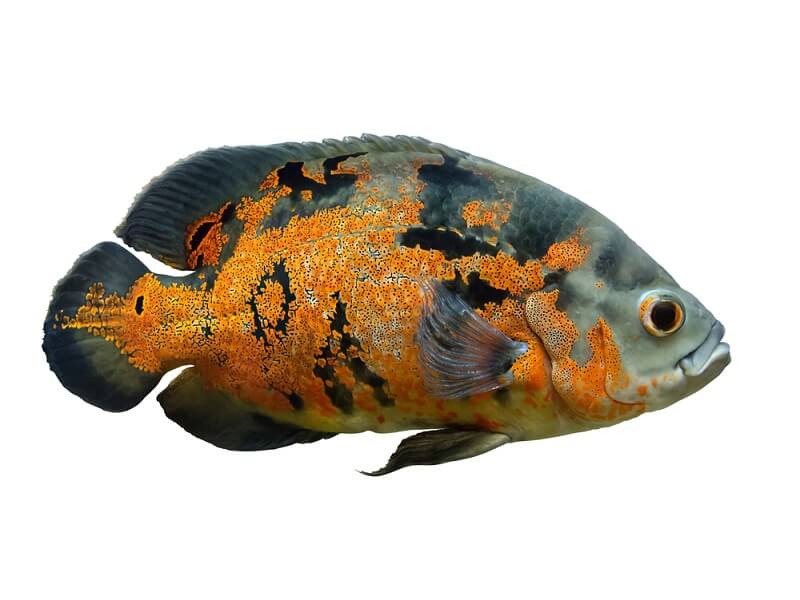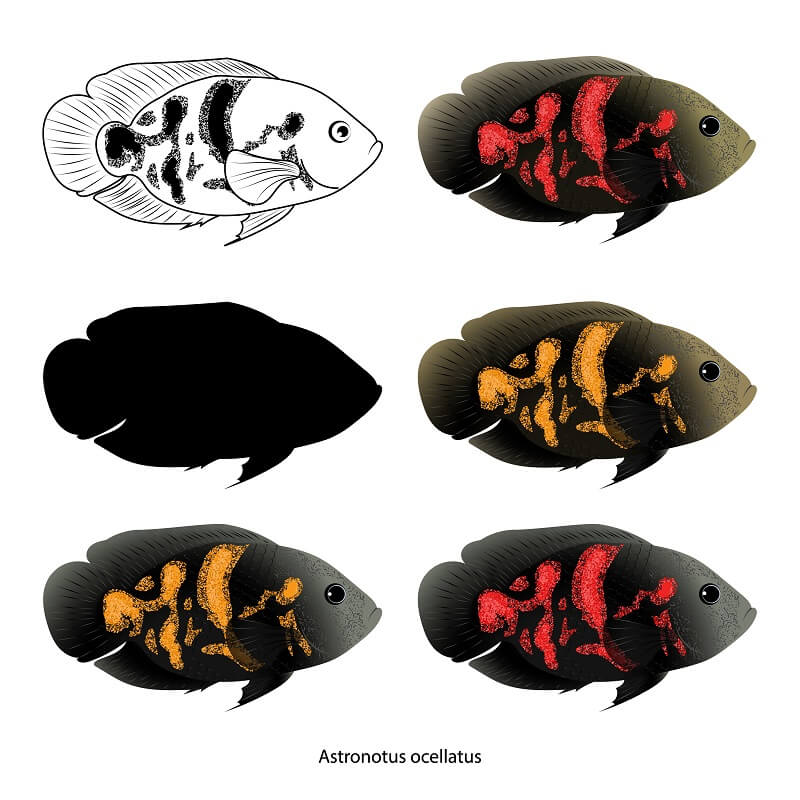
| Kingdom | Animalia |
| Phylum | Chordata |
| Class | Actinopterygii |
| Order | Cichliformes |
| Family | Cichlidae |
| Genus | Astronotus |
| Species | Astronotus ocellatus |
| Niche | River Predator |
| Length | Up to 18 in (45 cm) |
| Weight | Up to 3.5 lbs (1,600 g) |
| Lifespan | Up to 10 years |
| Social Structure | Territorial, solitary or in pairs |
| Conservation Status | Least Concern |
| Preferred Habitat | Warmer Rivers |
| Average Clutch Size | 1,000 – 3,000 eggs |
| Main Prey Species | Smaller fish, crustaceans, insects, sometimes fruit or nuts |
| Predators | Humans, wolves, wolverines, tigers, birds of prey |
The Basics
The oscar fish (or simply oscar) is a species from the cichlid family that is commonly kept as a freshwater aquarium species. The oscar comes from parts of South America – namely the Amazon River basin – though it has been introduced to many areas around the globe. As an aquarium species, there are many different varieties of oscar fish.
The most common variety is the “tiger oscar,” which is very similar to the wild oscar fish. There are also albino varieties, leucistic (mostly white) varieties, and xanthistic (yellowish) varieties. While these varieties are sold under a variety of different trade names, they are still part of the Astronotus ocellatus species.

Oscars are predatory fish in the wild, and they feed on a large number of smaller organisms including catfish, crustaceans, and aquatic insect larvae. To capture prey, oscars typically create suction by rapidly expanding their mouth to suck smaller organisms in. In captivity, these fish do well on many diets intended for large carnivorous fish – though they do have a special requirement for vitamin C that they sometimes get through eating fallen fruits in nature.
Though the oscar is native to parts of South America, its prevalence as an aquarium species has led to many introduction events in rivers around the world. Some wild oscars are now found as far away as China! These introductions can pose challenges for native organisms in an ecosystem that have not adapted to the large predator.
Interesting Insights from the Oscar Fish!
While the oscar is a commonly kept aquarium fish, many owners are not aware of the amazing biological concepts their fish displays. In fact, the oscar is a perfect example of the following concepts!
Suction Feeding
Gulp in as much air as you can. Did you suck up an apple sitting 3 feet away? Probably not… But, that’s exactly how the oscar fish eats!

Oscar fish – like many other predatory fish – use the viscosity of water to their advantage. Unlike air, which moves freely around objects, water is much denser. Plus, water molecules pull on each other through the process of cohesion. So, when the oscar opens its mouth quickly, a massive wall of water is sucked in.
Smaller fish unlucky enough to be caught in the wave are pulled into the oscar’s mouth, with no hope of escaping. Besides fish, many other aquatic organisms use suction feeding to their advantage. Notable suction feeders include some species of shark, newts, catfish, and many others. Suction feeders are typically “ambush predators” – waiting carefully for their prey to come close enough to be caught in the suction vortex!
Invasive Aquarium Fish
The oscar fish is not the only fish that has expanded its range since it has been commonly kept as an aquarium species. Unfortunately, the aquarium industry has introduced many invasive species into natural environments around the world. While the environmental impact of oscar fish releases has not been well studied, other aquarium species that have been released are wreaking havoc on natural environments.
For example, the Zebrafish is a commonly kept saltwater aquarium species. The fish is beautiful, colorful, and very interesting to watch in captivity. For this reason, the fish was imported to the United States from its native range in the Indian Ocean. However, a few Zebrafish were accidentally released into the Gulf of Mexico. Only a few decades later, the Zebrafish has become a massively destructive species along many reefs in the Gulf.
Since the Zebrafish is a voracious predator and has a number of protective spines, it can eat almost everything and has no natural predators in the Gulf of Mexico. As such, Zebrafish populations have exploded and are rapidly depleting many fish species important to the health of the coral reef. In fact, this invasive species is so destructive that is has been partially blamed for the loss of corals from South America to Florida.

Brood Care
Though the oscar is a voracious predator, these fish can also make very protective parents. Oscar fish naturally defend their territory, chasing off all other fish that come too close and eating anything small enough to fit in their large mouths!
However, when it comes to their babies, oscars are very careful. In fact, the oscar fish will protect its babies and is very careful not to suck them up. This is known as “brood care” and is a type of parental care seen in several fish species. While most fish simply release their eggs into the environment, the oscar will protect its offspring until they are large enough to leave and established their own territory.
